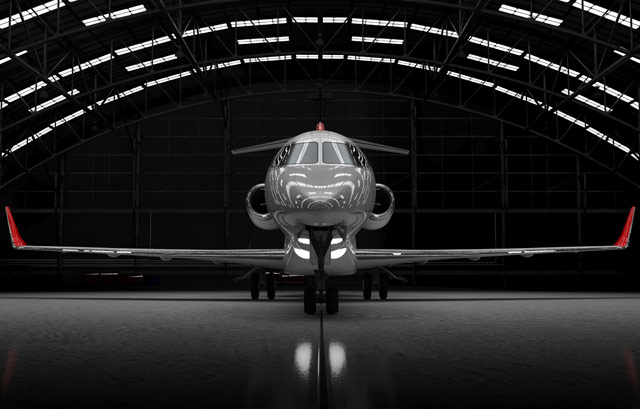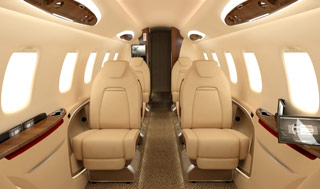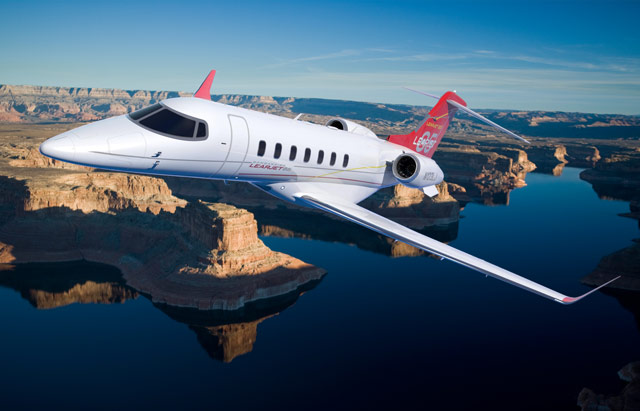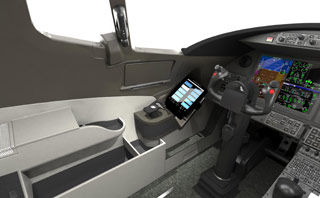Bombardier launched the Learjet 85 in 2008 with a bold plan for production. Ever since Bill Lear founded the company nearly half a century ago, Learjet manufacturing was concentrated almost exclusively in Wichita, Kansas, the self-described "air capital of the world", which boasts more than a century of aviation manufacturing experience.
But for the all-composite Learjet 85, Lear's successors decided to move all structures - and a portion of the assembly work for the latest midsize business jet - elsewhere. More precisely, Bombardier relocated the work 2,100km (1,130nm) south of Wichita to a city of one million on the high mesa of central Mexico - Querétaro
 |
| Bombardier First flight of the Learjet 85 is set for 2013 |
Here, a mostly locally recruited workforce are constructing the Learjet's major fuselage structures, including the single-piece forward fuselage made from out-of-autoclave composite material. The assembled structures, including the composite aft fuselage, are then trucked north and across the border to Wichita.
The five-year-old programme is entering a critical phase. Bombardier has advertised first flight of the Learjet 85 for 2013. The first two fuselages - for the structural test article and the first flight-test aircraft - have been delivered to Wichita.
"The final assembly line is up and running. The aft fuselage and pressure fuselage is being joined. We already have the nose cone, and the pressure vessel is already joined. So the structure is coming together nicely," says Ralph Acs, Learjet vice-president and general manager.
 |
| Bombardier Cabin interiors will be installed in Wichita |
In September, Bombardier allowed journalists to enter the two-year-old production complex in Querétaro for the first time. The tour revealed a remarkably self-sufficient facility as an aerospace factory in central Mexico cannot depend on a network of local suppliers for manufacturing services such as quality inspection. The Learjet 85 programme also cannot afford to wait several days to ship coupons of production material back to Wichita.
Bombardier's solution is to test all production materials on-site. Facilities include a General Electric-designed ultrasound machine that checks for voids in composites parts. The part is held aloft on a gantry, where it is rotated and sprayed with water. Soundwaves then pulse through the part, first creating a detailed map of the layers of composite structure and then detecting any voids caused by air bubbles.
In another area of the plant, quality inspectors take coupons of every part built inside the factory, which are then cut up and analysed for production errors.
"With Bombardier and Learjet 85, we go to the highest levels that we can go," says Bombardier quality manager Norman Thompson. "In this facility, we've got the capability. A lot of companies and operations farm out this stuff - but we don't. So, if we need a test on a part on Friday night at 10:30, we can do it."
Learjet's presence in Mexico began in 2007 at El Marques, a site about 10km away, where Bombardier employs 1,700 staff to build structural components and wiring harnesses. El Marques gave Bombardier the confidence to push more work into the rapidly growing aerospace cluster in central Mexico.
BEYOND WICHITA
Two years later, Bombardier started constructing the Learjet 85 factory next to Querétaro airport. The 16,700m² (180,000ft²) plant builds nine major Learjet 85 components, including the forward fuselage, aft fuselage, nose, tail cone, vertical stabilisers and horizontal stabilisers.
Outsourcing work to different sites within its corporate portfolio is common practice for Bombardier. A decade before the Learjet 85 was conceived, the company's Short Brothers division in Belfast was assigned to build the aluminium fuselage for the CRJ700/900/1000 regional jets, which are then assembled near Montreal. For the CSeries programme, Bombardier entrusted the centre fuselage to AVIC's Shenyang Aircraft in China.
However, that level of outsourcing work was something new for the Learjet division. Its last major aircraft development programme, the Learjet 60, was manufactured almost completely at Wichita.
Work has gone outside to other companies in almost every development programme during the past 10-15 years, but even with Bombardier sister companies "there is a sharing of work", says Acs. "In terms of our case, it was chosen that we would invest and work out of Mexico."
Opening a factory in the aviation business has its own specific risks. Tolerance levels for flaws or error are lower than almost any other form of mass production. A low-cost workforce is always desirable, but not at the expense of delivering a safe product. If Bombardier harboured concerns about training the local workforce rapidly enough, they seem satisfied by the result.
 |
| Bombardier Querétaro builds the fuselage and most of the Learjet 85’s wings using composite materials |
"[Querétaro] is a young, up-and-coming company," Acs says. "The quality you get coming out of there is equivalent to the quality you get at other Bombardier sites."
It was originally expected that Querétaro would assemble the aft fuselage to the forward fuselage before the single barrel was shipped to Wichita to be mated with the wing, stabilisers, engines, systems and landing gear. However, Learjet has so far adopted a more cautious approach for the first two articles delivered - the aft fuselage and forward fuselage were shipped separately and mated at the final assembly centre in Wichita.
To complicate things further, Bombardier's Mexico-based workforce also had to take on the challenge of building the entire fuselage and most of the Learjet 85's wings using composite materials, a first for the previously all-aluminium-skinned Learjet family. Perched almost 1,830m (6,000ft) above sea level, the lower air density works against the pressure required for bonding the layers of composite skin. As a result, workers must "de-bulk" the layers of composite material every few hours, a process which removes any air bubbles that form due to lack of sufficient air pressure during the curing process.
LAYERS OF COMPLEXITY
The structure of the Learjet 85 composite fuselage comprises 50-75 individual plies, laid-up piece-by-piece on moulds, covered in a vacuum bag and cured at high temperatures. The layer begins with a single ply, which is covered with a copper mesh to act as a Faraday cage in case of lightning strike. Adhesive film, a carbon weave, surfacing film, carbon-based unidirectional plies, and an interleaf - to serve as a water barrier - are applied on top of that.
While other manufacturers tend to adopt either honeycomb or a monolithic laminate - the Hawker 4000 fuselage is made almost entirely from honeycomb composite, while the Boeing 787 relies mainly on monolithic laminate strengthened by metal stringers - Bombardier has chosen to use both styles for the Learjet 85's fuselage.
The aircraft's designers decide between honeycomb and monolithic composite based on thickness of the required structure.
"It's based on the structural design, where they have room to have more plies. Honeycomb is going to make it thicker, monolithic is thinner, but honeycomb is going to give you less weight than adding plies of material. It's a fine line between how we make the honeycomb or the monolithic in the parts of the material," says James Funk, general manager of Learjet 85 operations.
Querétaro has long been a target of outsourcing strategies for aerospace manufacturing, but no project there is more technically ambitious than the Learjet 85's composite fuselage barrel, and no company has more lofty plans for Querétaro than Bombardier.
Construction is already under way on buildings adjacent to the Learjet 85 factory, where Bombardier will build the aft fuselage for the Global 7000 and Global 8000 large-cabin jets.
Even within Bombardier, the Querétaro site has risen up the Learjet supply chain. The Short Brothers site in Belfast ships the composite skins for the Learjet 85 to Querétaro, where they are put together in completed assemblies.
 |
| Bombardier The Learjet 85 will feature a glass cockpit |
The workers first assemble the wing skeleton, including the front spar, auxiliary spar, rear spar and centre box inside a horizontal tool. The wing-box is then loaded into a vertical position where the skins are attached to the skeleton. Next, workers move the wing into another horizontal position to install final components and seal the fuel tanks.
In mid-September, the Querétaro plant had both wing sets for FTV-1 and the structural test article in the vertical positions, with completion scheduled for November. The completed wings will be shipped to Wichita, where the wings will be joined to the fuselage, and assembly completed by installing the avionics, landing gear and cabin interiors.
Indeed, both fuselages were on display in the final assembly hangar in Wichita. Sitting nearby were a pair of Pratt & Whitney Canada 307Bs, which were being instrumented for flight test before installation on FTV-1. In Toronto, P&WC and Bombardier were conducting tests on the engine's new thrust reversers which, Funk says, are "progressing quite well".
The structural test article will be inducted into the National Institute for Aviation Research (NIAR), an aerospace certification and testing house affiliated with Wichita State University. The NIAR is transforming an abandoned Wichita civic centre into a testing facility for aircraft structures.
While awaiting the wing sets from Querétaro, the Learjet 85 team in Wichita is focusing on aircraft systems and the Rockwell Collins Vision Flight Deck - a glass cockpit with synthetic vision and auto-throttles.
Bombardier has activated a systems integration test simulator (SITS) in Wichita to run through the maturity of the avionics software, with the goal to achieve entry into service reliability at first flight. That means Bombardier is driving its suppliers to deliver components and software at a higher maturity level than typically demanded by a manufacturer, Acs says.
"The more mature the systems are, the easier it will be to go through the flight-test programme," he adds. "When [systems suppliers] send us something, I don't want to take it off [the aircraft] again. These are the ground rules we have with our supply base."
In mid-September, Bombardier was running the aircraft systems through a third loop of testing in the SITS. On every loop, new problems are identified and the supplier comes back with a fix. Past Learjet programmes required suppliers to go through the process only twice, Acs says.
"Find things, roll it away, clean it up and come back," he says. "The important thing is you are touching things up."
Source: Flight International























